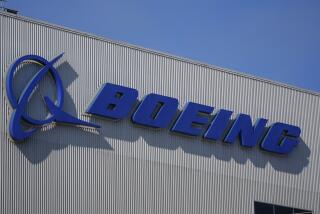UAL Will Discuss Union Buyout but Calls Offer Too Low
- Share via
NEW YORK — UAL Corp., parent of United Airlines, announced Thursday that it would negotiate with the unions and the investment company that are conducting a proxy fight for control of the corporation but said their recent offer was not high enough.
UAL’s pilots, machinists and flight attendants unions, along with the New York investment firm of Coniston Partners, on Monday offered about $4.1 billion for the company. After an all-day meeting here Thursday, the UAL board of directors said, “There is a disparity between the value of the proposal and the otherwise realizable value of the company.”
The board reiterated that the company and its parts are for sale and directed its financial advisers “actively to develop a plan for asset dispositions, to consider any proposals for the purchase of the entire company by other parties and to address all other alternatives for realizing greater and fair value for the shareholders.”
If the proxy fight mounted by Coniston and the three unions succeeds, it would probably mean the ouster of UAL’s chairman, Stephen M. Wolf.
The United board said the unions and Condor Partners, the entity owned by Coniston which is waging the proxy fight, had asked Wednesday for negotiations in an attempt to reach agreement before the campaign for proxies begins.
“Despite serious deficiencies which the board believes exists in the buyout proposal, including its value and financeability,” the directors said in their statement, “the board has instructed its advisers to enter into the requested negotiations.”
Coniston said Monday that it and the unions had not arranged financing for the proposed deal, saying they would await the outcome of the fight for control of the board at UAL’s annual meeting, which is scheduled for April 26.
The buyout offer would give shareholders $150 a share in cash, $25 a share in 10-year notes bearing 15% interest, and non-voting common stock constituting 25% of the new company’s total common equity. The remaining 75% would be held by an employee stock ownership plan.
Paul E. Tierney Jr., a partner in Coniston, said in a telephone interview after the UAL board’s announcement Thursday, “I think it is smart to meet. I hope the negotiations are fruitful. It is better to do this in a friendly fashion. Our slate (of board nominees) is filed. We are continuing the proxy fight. There is no change in our direction.”
Coniston, which is UAL’s largest single shareholder with 11.8%, said its 15-member board slate consisted of four union representatives, three Coniston partners and eight other people. The unions are the Air Line Pilots Assn., the International Assn. of Machinists & Aerospace Workers, and the Assn. of Flight Attendants.
Observers noted that the board had few alternatives and virtually had to talk with the unions.
“The board was limited in its range of options,” said Timothy Pettee, airline analyst in New York with the Merrill Lynch investment firm. “They clearly could not dispatch the proposal summarily. They have to entertain the overture, as it does represent nearly 12% of the shareholders and the majority of the employees.”
Pettee added that although financing is harder to get now than it was last year and leveraged buyouts are no longer in vogue, a financier might come forward to try to buy UAL. He said possible buyers might well be impressed with the fact that last year’s takeover of Northwest Airlines by a group headed by Los Angeles financier Alfred A. Checchi “is going so well.”
Observers said they doubt that UAL will be liquidated to fend off the pursuers, but they noted that the airline has certain assets that could be sold. For instance, they said, it owns half of Covia, the company that operates its Apollo computer reservation system, the nation’s second largest. The other half was sold for $500 million last year to a group of other airlines. United’s half is estimated to be worth between $600 million and $700 million now.
United could also sell off its lucrative Pacific routes, which it bought from Pan Am Corp. in 1985 for $750 million. This is considered doubtful, however, since the Pacific division is considered the most valuable part of the airline. As another alternative, it could sell older planes, or it could sell some of its new planes and lease them back.
More to Read
Inside the business of entertainment
The Wide Shot brings you news, analysis and insights on everything from streaming wars to production — and what it all means for the future.
You may occasionally receive promotional content from the Los Angeles Times.










